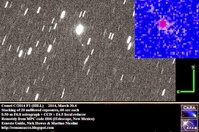COBS News archive
Rosetta takes comet's temperature
August 02, 2014
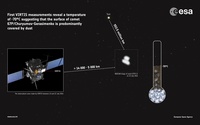
Rosetta's Comet: Imaging the Coma
August 01, 2014
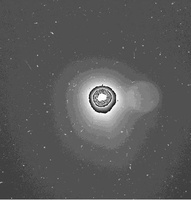
Surface impressions of Rosetta's comet
July 28, 2014

Surface structures are becoming visible in new images of comet 67P/Churyumov-Gerasimenko taken by the scientific imaging system OSIRIS onboard the European Space Agency's Rosetta spacecraft. The resolution of these images is now 330 feet (100 meters) per pixel. One of the most striking features is currently found in the comet's neck region. This part of 67P seems to be brighter than the rest of the nucleus.
NASA Mars Spacecraft Prepare for Close Comet Flyby
July 27, 2014
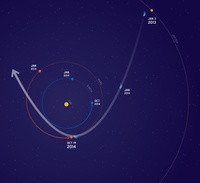
NASA is taking steps to protect its Mars orbiters, while preserving opportunities to gather valuable scientific data, as Comet C/2013 A1 Siding Spring heads toward a close flyby of Mars on Oct. 19. The comet's nucleus will miss Mars by about 82,000 miles (132,000 kilometers), shedding material hurtling at about 35 miles (56 kilometers) per second, relative to Mars and Mars-orbiting spacecraft.
New Views of the Rosetta Comet
July 25, 2014

NEOWISE Spots a Comet That Looked Like an Asteroid
July 24, 2014
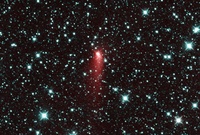
Comet C/2013 UQ4 (Catalina) has been observed by NASA's Near-Earth Object Wide-field Infrared Survey Explorer (NEOWISE) spacecraft just one day after passing through its closest approach to the sun. The comet glows brightly in infrared wavelengths, with a dust tail streaking more than 62,000 miles (100,000 kilometers) across the sky. Its spectacular activity is driven by the vaporization of ice that has been preserved from the time of planet formation 4.5 billion years ago.
Rosetta Spacecraft Approaching Twofold Comet
July 19, 2014

As the European Space Agency's spacecraft Rosetta is slowly approaching its destination, comet 67P/Churyumov-Gerasimenko, the comet is again proving to be full of surprises. New images obtained by OSIRIS, the onboard scientific imaging system, confirm the body's peculiar shape hinted at in earlier pictures. Comet 67P is obviously different from other comets visited so far.
New Comet: C/2014 N3 (NEOWISE)
July 14, 2014
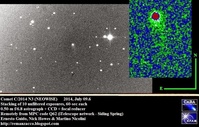
Cbet nr. 3921, issued on 2014, July 13, announces the discovery of a comet (~ magnitude 17) by the Near-Earth Object Wide-field Infrared Survey Explorer (or NEOWISE; formerly the WISE satellite) team on images taken with the NEOWISE satellite on 2014, July 04.5. The new comet has been designated C/2014 N3 (NEOWISE).
Comet Pan-STARRS Marches Across the Sky
July 08, 2014
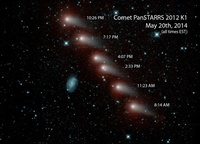
NASA's NEOWISE mission captured a series of pictures of comet C/2012 K1 -- also known as comet Pan-STARRS -- as it swept across our skies in May 2014. The comet is named after the astronomical survey project called the Panoramic Survey Telescope and Rapid Response System in Hawaii, which discovered the icy visitor in May 2012.
Rosetta's comet target 'releases' plentiful water
July 01, 2014
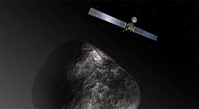
Comet 67P/Churyumov-Gerasimenko is releasing the Earthly equivalent of two glasses of water into space every second. The observations were made by the Microwave Instrument for Rosetta Orbiter (MIRO), aboard the European Space Agency's Rosetta spacecraft on June 6, 2014. The detection of water vapor has implications not only for cometary science, but also for mission planning, as the Rosetta team prepares the spacecraft to become the first ever to orbit a comet (planned for August), and the first to deploy a lander to its surface (planned for November 11).
Rosetta Closing in on Comet
June 23, 2014
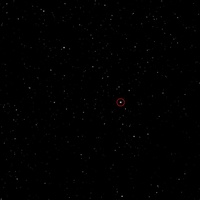
Less than half the distance between Earth and moon separates Rosetta from its destination, comet 67P/Churyumov-Gerasimenko. The European Space Agency's (ESA) spacecraft will become the first to orbit a comet and land a probe on its nucleus. It is beginning observations and sending science data back to Earth.
New Comet: P/2014 L2 (NEOWISE)
June 16, 2014

NASA instruments on Rosetta start comet science
June 13, 2014
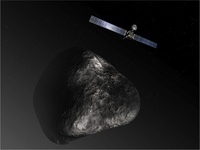
Update on comet C/2012 K1 (PANSTARRS)
June 12, 2014
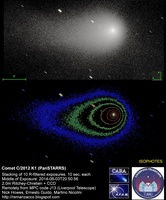
New Comet: C/2014 J1 (CATALINA)
May 19, 2014
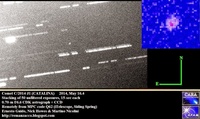
Cbet nr. 3868, issued on 2014, May 16, announces the discovery of an apparently asteroidal object (~ magnitude 18.2) on CCD images taken on 2014, May 09.3 by R. J. Sanders with the Catalina Sky Survey's 0.68-m Schmidt telescope. This object has been found to show cometary appearance by observers elsewhere. The new comet has been designated C/2014 J1 (CATALINA).
Rosetta's Target Comet is Becoming Active
May 17, 2014
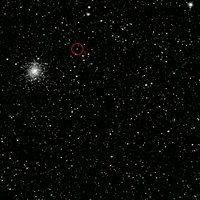
Rosetta space probe: Landing on a comet to observe nucleus and environment
May 12, 2014

In March 2004, the Rosetta orbiter was launched into space to analyse and observe the nucleus and environment of the comet 67P/Churyumov-Gerasimenko. Little research has been done on comets and they still hold many secrets. One theory is that comets brought water (and thus possibly even life) to Earth. Although space probes have been able to carry out isolated investigations, this has only been while the comets were flying past. At least until now. This will be the first probe not only to collect measurement data "en passant" as it were, but to accompany the comet -- and even to land on it.
A New Meteor Shower in May?
May 06, 2014
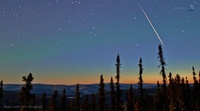
Comet 209P/LINEAR & its Meteor Shower
April 19, 2014
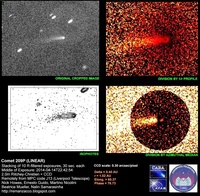
209P/LINEAR is a periodic comet discovered by the Lincoln Laboratory Near-Earth Asteroid Research (LINEAR) survey on five images taken on 2004, February 3.40 (discovery magnitude ~18.1). Reported by LINEAR as an apparent asteroidal object, it has been found to show a narrow 1'.1 tail in p.a. 274 deg (slightly expanding toward the end) on CCD images obtained by R. H. McNaught with the 1.0-m f/8 reflector at Siding Spring on Mar. 30.8 UT.
New Comet: C/2014 F1 (HILL)
April 02, 2014
